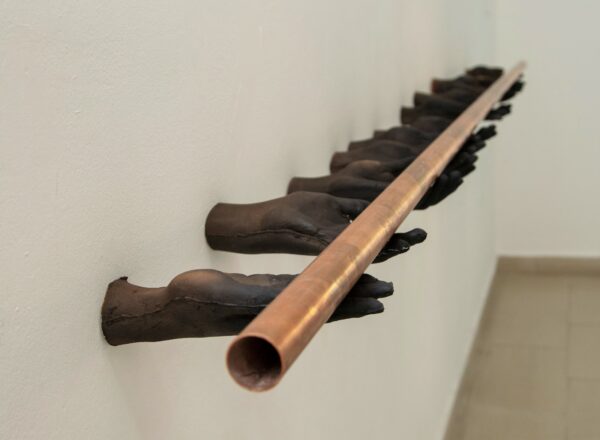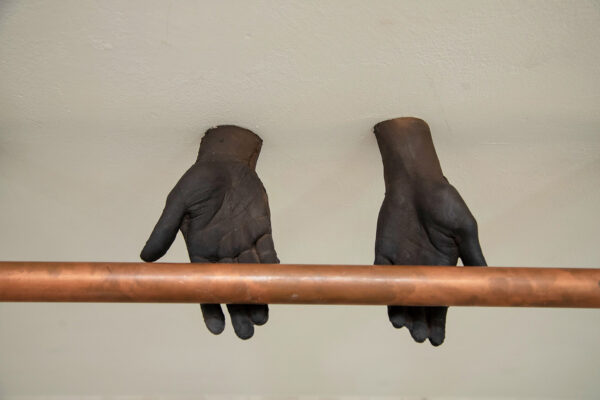Artista : Zejak Veljko
Immagini
Dettagli
Altezza (cm): 20
Larghezza (cm): 250
Profondità (cm): 30
Peso (kg): 7
Materia e tecnica: Lega metallica = rame / copper.
Tecnica: Art work is composed of 12 casts of hands placed in a line on the wall. Hands are holding copper pipe line for gas 2.5 m long. Hand are hang on the wall with iron stick that are placed in the hands on the one side and on the other they are attached in the wall.
Anno di completamento: 2022
Edizione
L’opera è il risultato di un workshop con i migranti provenienti dal Medio Oriente e dall’Africa. È composta da calchi in ceramica di mani di rifugiati e da un tubo di rame. Le mani fuoriescono dal muro, lasciando intendere che vi sono persone intrappolate. L’unica cosa che può confermare la loro identità sono le impronte digitali. La posizione delle mani suggerisce un’implorazione di aiuto, allo stesso tempo tengono i tubi del gas come se li stessero offrendo. Il tubo sembra in bilico sulle mani, producendo così una sensazione di incertezza e trepidazione poiché potrebbe cadere da un momento all’altro.
The artwork resulted from a workshop with the migrants from Middle East and Africa. It is comprised of ceramics casts of refugees’ hands and a copper pipe. The hands are sticking out of the wall, implying that there are people trapped. The only thing that can confirm their identities are their cast fingerprints. The position of the hands suggests begging for help, while holding gas pipelines may be an offer. The tube seems to hover over them, thus producing a feeling of uncertainty and trepidation since they give the impression that it will fall at any moment.
62° Premio Faenza – Menzione d’onore / Honorary mention
Veljko Zejak attraverso questo lavoro pone l’attenzione su una emergenza mondiale e sociale legata all’emigrazione, allo sfruttamento delle risorse, all’integrazione, al rispetto dei diritti umani e sociali, all’identità. Stiamo assistendo in questi ultimi anni allo spostamento di un numero considerevole di persone in tutte le aree geografiche del mondo, emigrazioni forzate da situazioni di necessità come guerre, emergenza climatica, fame, persecuzioni. Migliaia di persone abbandonano luoghi nativi con la speranza di essere accolti in paesi dove possono immaginare un futuro per se stessi e per le loro famiglie, chiedendo un aiuto concreto per una nuova vita. Le mani di Zejak pongono lo spettatore in una prospettiva di profondo disagio, stimolando interrogativi senza risposte.
Through this work, Veljko Zejak draws attention to a global and social emergency linked to emigration, exploitation of resources, integration, respect for human and social rights, and identity. In recent years, we have been experiencing the displacement of a considerable number of people in all geographical areas of the world, emigrations forced by situations of necessity such as wars, climate emergency, hunger, persecution. Thousands of people leave their native places with the hope of being welcomed in countries where they can imagine a future for themselves and their families, asking for concrete help for a new life. Zejak’s hands place the viewer in a perspective of deep unease, stimulating questions without answers.
(Claudia Casali)


